Published: 22 June 2023
As of April 2023, EU+ countries were under increasing pressure due to the high number of asylum applications being lodged, according to the European Union Agency for Asylum (EUAA)’s latest asylum trends report. Around 75 000 asylum applications were lodged in April which, while lower than previous months, contributes to an increasing caseload of 687 000 applications pending a first instance decision, the highest since 2017.
According to analysis just released by the European Union Agency for Asylum (EUAA), EU+ asylum authorities are under increasing pressure from the number of asylum applications, with around 75 000 applications being lodged in April. Since May 2022, there has been an ongoing increase in applications for international protection in the EU+, fuelled by conflict, political and social upheaval, economic hardships, and food insecurity.
Germany: the country with most applications
In April 2023, Syrians (8 800) and Afghans (7 000) continued to lodge the most applications for asylum, with the former increasing by 36% year-on-year. Around half of all Afghan applications and a significant 60% of all Syrian applications were lodged in Germany. Turks (4 700) also lodged many applications in April, up by nearly two thirds compared to April of last year with, again, more than half of all applications being lodged in Germany.
High caseload
The number of cases awaiting first instance decisions reached 687 000 in April 2023. This level has not been seen since early 2017, when EU+ countries were still processing cases lodged during the so-called migration crisis of 2015-2016.
For the most part, the citizenships lodging the most applications also have the most cases awaiting decisions. In April 2023, Syrians and Afghans had the most cases pending at first instance by far, with 85 000 and 71 000 cases, respectively. The caseload for Syrian nationals was up by 26% compared to April 2022, but the caseload remained more or less stable for Afghan nationals.
However, pending cases have more than doubled over the last year for Colombians and Peruvians (mostly in Spain), Turks and Iranians (mostly in Germany), and Egyptians (mostly in Italy). In the case of the Latin American nationalities this is unrelated to irregular migration; but is due, in large part, to a persistent pattern of asylum applications being lodged by Venezuelans and Colombians, and to a lesser extent Peruvians, all of whom can enter the Schengen area without a visa.
Highest recognition rate in almost a year
In April 2023, the recognition rate stood at 42% based on decisions granting either refugee status or subsidiary protection, which is the highest level since June 2022. Recognition rates for most of the main citizenships differ widely from each other but tend to remain stable over time. For example, in April 2023, Iranians continued to have a recognition rate of around 48%, Bangladeshis 4% and Pakistanis 10%.

